User Affinity Configuration
Overview
You can use the User Affinity Configuration to rank product recommendations based upon each user's individual affinity to categories, brands, or product attributes. Affinities are dynamically determined as the user interacts with your products. Recommendations are re-ranked to better match the user's individual affinities.
User Affinity Configuration can result in significant improvements in attributable sales from product recommendations.
By saving the User Affinity Configuration, a new strategy is automatically available, AffinityRankedClickCP. This strategy can be used on your site, such as on your item page. AffinityRankedClickCP re-orders the product recommendations based upon their match to each user's individual affinity scores. For example, if a user has a strong affinity for a certain color, then the product recommendations will be automatically changed to better match the user's affinity to color.
Setting It Up
The User Affinity Configuration can be set up within the dashboard. Once set up, the AffinityRankedClickCP strategy is available for use. You can set up multiple user affinity configurations to be used for different channels, such as online and email, as the configurations may need to be different.
On the Omnichannel Personalization dashboard, go to Optimization > User Affinity Configuration.

Here is where you will set up the categories, brands, and product attributes that you will use when scoring a user's affinity. As each user interacts with your products, their affinities are being recorded based upon their activity. The activities tracked are product views, add to cart actions, and purchases. Each of these activities results in a change to the score for the user for each of the categories, brands, and product attributes. Each activity contributes a different score.
To configure the categories, brands, and product attributes, the following options are available:
-
On the Affinity Configuration page, click Add Config. The following page is displayed with the Configuration tab by default..
-
Click Add attribute.
- Add product attributes. For example, color or gender. You can enter the names of the product attributes to be included. For example, if you want to add Color as an attribute for user affinity, you can click to add attributes, enter Color in the space provided. To enter more than one attribute at a time, you can enter each separated by a semicolon.

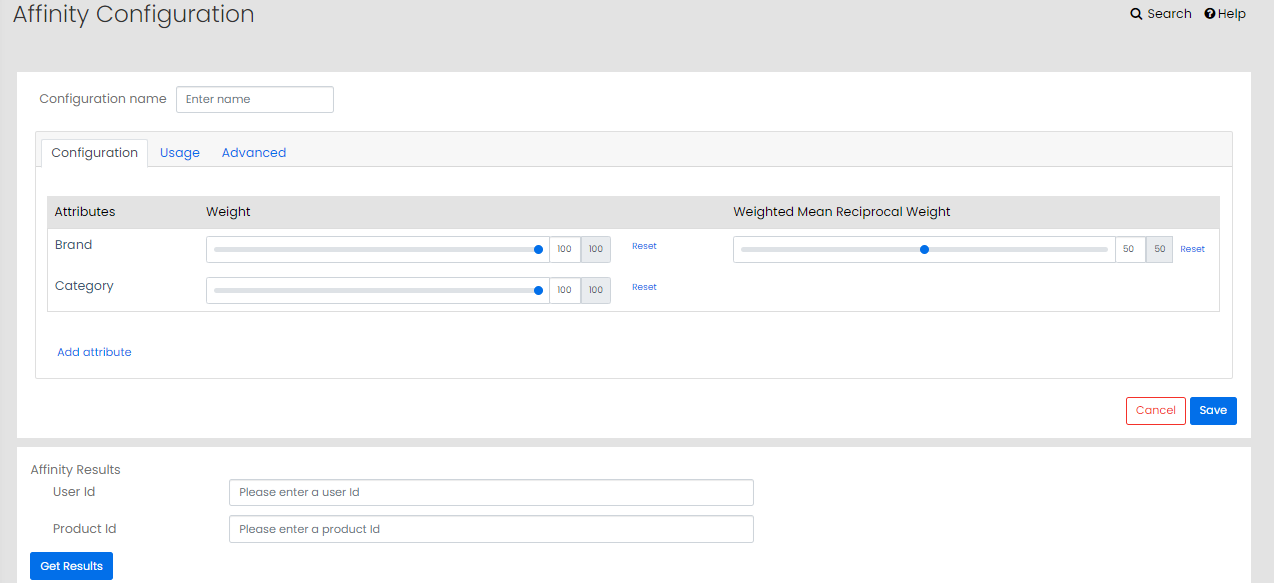
-
Click OK.
-
Enter the configuration name.
- Adjust weights for brand, category, and the product attributes. In this case, you may want to emphasize one of brand, category, or product attributes over the others. To do this you can adjust the weights using the slider bars. You can also use the weights to not use brand, category, or product attributes by setting the weight to 0.

-
Adjust the Weighted Mean Reciprocal Weight used to blend the results of the ClickCP recommendations with the affinity-based product recommendations. In this case you are choosing to emphasize either ClickCP recommendations or affinity-based recommendations. If you set it to 100, then you will always use affinity-based recommendations. If you set it to 0, you will always use ClickCP recommendations without the effects of affinity. If you set it to 50, you will blend them evenly.
-
Click Save.
Usage
On the Usage tab, optimization managers can view all rules, campaigns, and strategies associated with a specific User Affinity Configuration, ensuring better visibility and preventing accidental deletion of active configurations. The Usage tab on the User Affinity Configuration list page displays the linked Configurable Strategies, Advanced Merchandising rules, Boosting rules, and Engage Campaigns.
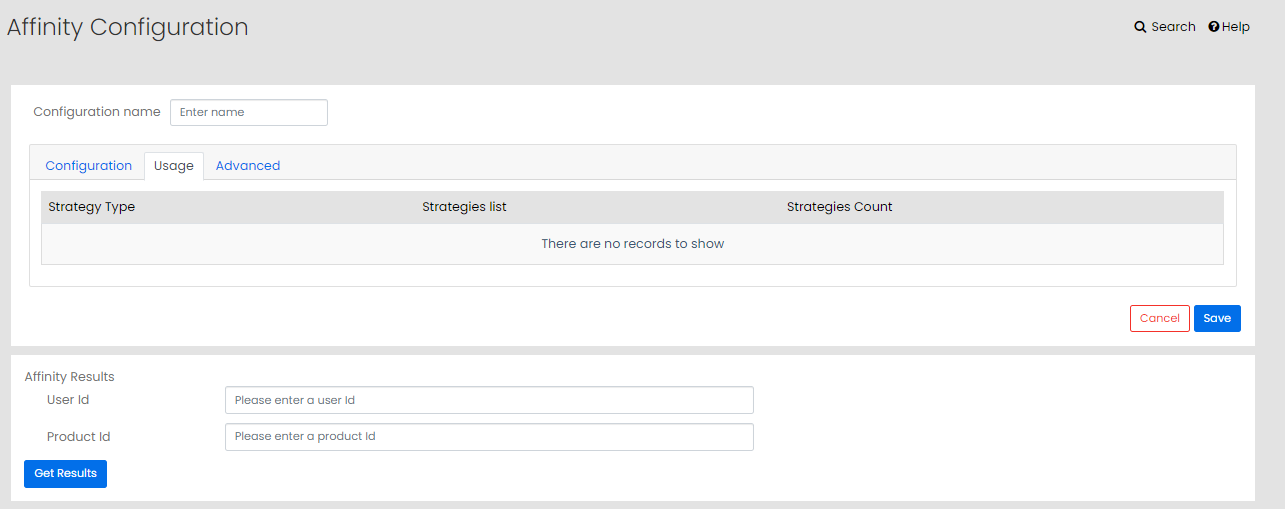
Advanced
On the Advanced tab, merchandisers can adjust previously hard-coded values for events such as cart actions, purchases, and views. Additionally, new parameters like OLD_PURCHASE_WEIGHT and configurable time frames for when views and purchases are considered "old", with defaults set to 90 days.
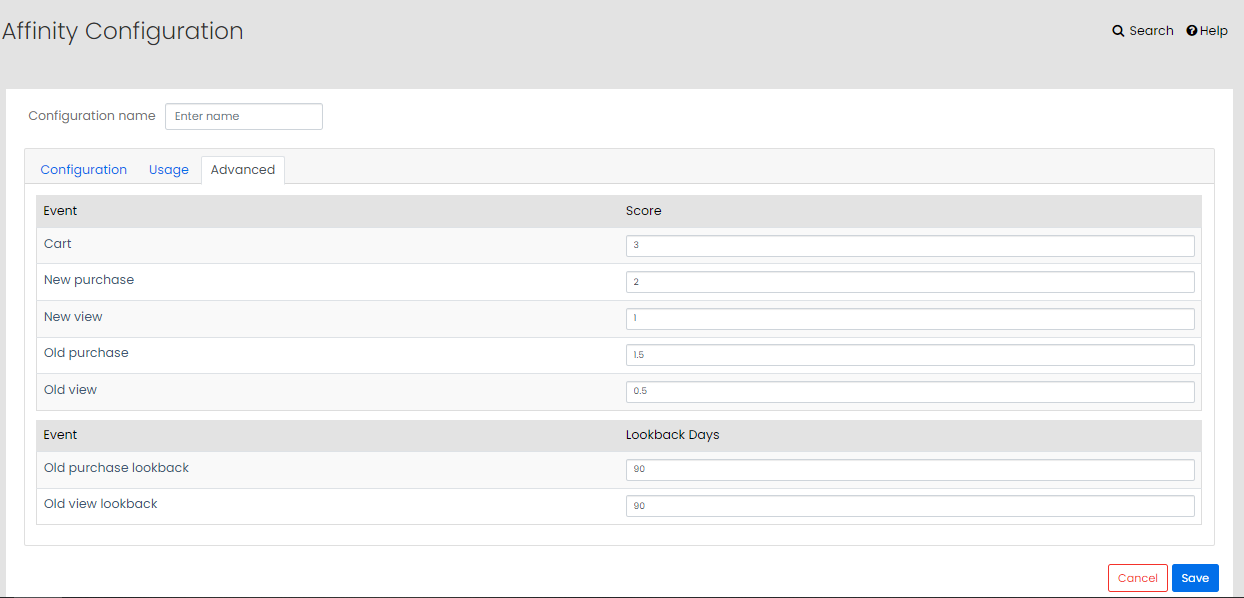
On the Advanced tab, the following event scores are included with the default values:
-
Cart = 3. Maximum value is 10.
-
New Purchase = 2. Maximum value is 10.
-
New View = 1. Maximum value is 10.
-
Old Purchase = 1.5. Maximum value is 10.
-
Old View = 0.5. Maximum value is 10.
-
Old purchase lookback: Number of days a Purchase is considered Old: 90. Maximum value is 365.
-
Old view lookback: Number of days a View is considered Old: 90. Maximum value is 365.
Testing Your Configuration
You can test the configuration settings at the bottom of the screen. If you enter a user ID, you can click Get Results to get the results and it will show you the affinity scores for this user for the affinity attributes that you have configured above.
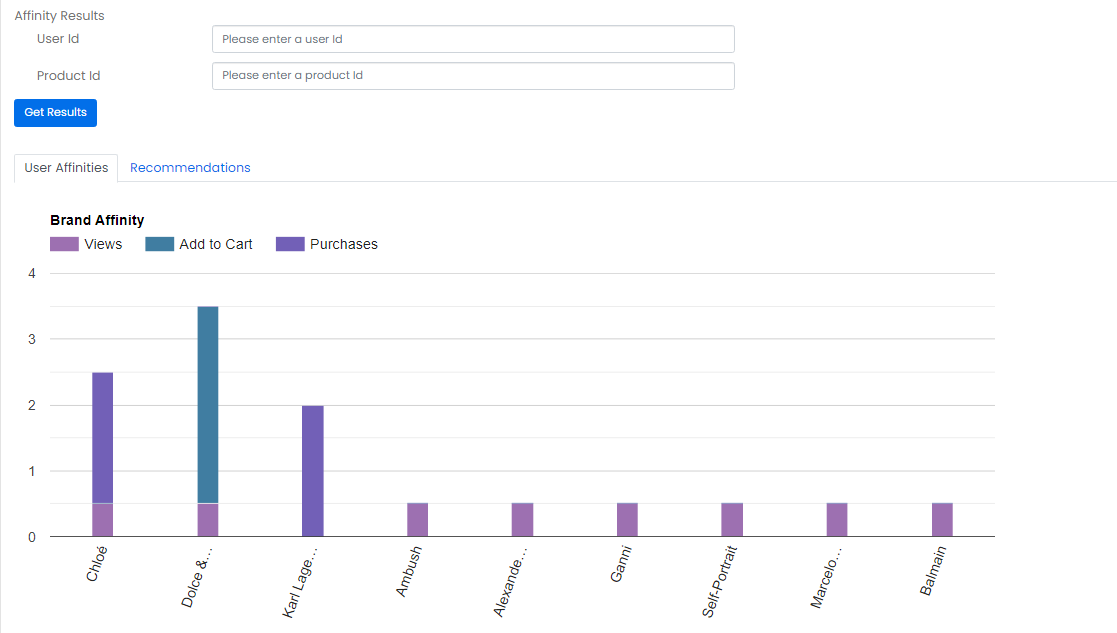
By entering a product ID and clicking Get Results, you can see the recommendations that will be given to the user when they land on that product, or when that product is the seed.
The affinity scores are calculated on the fly for each user, using UPS data and are derived based on Views, Add to Cart, and Purchases. Based on the scores of products for each affinity, multiple stacked bar charts show the users affinity towards Brands, Categories and other product attributes.
This is the ascending order sorting of the scores for each Category/Brand/Attributes of products:
For example,
Events for Customer C1
| Product 1 (Brand A) | Product 2 (Brand B) | Product 3 (Brand A) | Product 4 (Brand C) | |
|---|---|---|---|---|
| Product View | 6 |
3 |
4 |
5 |
| Add to Cart | 0 |
1 |
1 |
2 |
|
Purchase |
0 |
0 |
1 |
2 |
|
Final weighted score |
6 |
5 |
9 |
15 |
Brand Affinity Calculation for Customer C1
| Weight | Brand A | Brand B | Brand A | Brand C | Brand A | |
|---|---|---|---|---|---|---|
| Product View | 1 | 6 | 3 | 4 |
5 |
10 |
| Add to Cart | 3 |
0 |
3 |
3 |
6 |
3 |
|
Purchase |
2 |
0 |
0 |
2 |
4 |
2 |
|
Final weighted score |
6 |
6 |
9 |
15 |
15 |
|
|
|
|
|
|
|
|
|
|
Affinity with Brand |
A | B | C |
|
|
|
|
|
15 |
6 |
15 |
|
|
|
Customer has higher Affinity for Brand A and C followed by Brand B
Algonomy Personalization platform has below logic to calculate scores of products for each user :
-
Weightage for a Add to Cart is 3
-
Weightage for a Product View is 1
-
Weightage for a Purchase is 2
Here you can see 3 tabs. The first tab lists the product recommendations that the new AffinityRankedClickCP strategy will show the user when they land on the product specified. If you click on the ClickCP tab, it lists the product recommendations that ClickCP would show. If you click on the Affinity-based Rank tab, it will show the product recommendations that would be shown is you want product recommendations to be based 100% on affinity of the user.
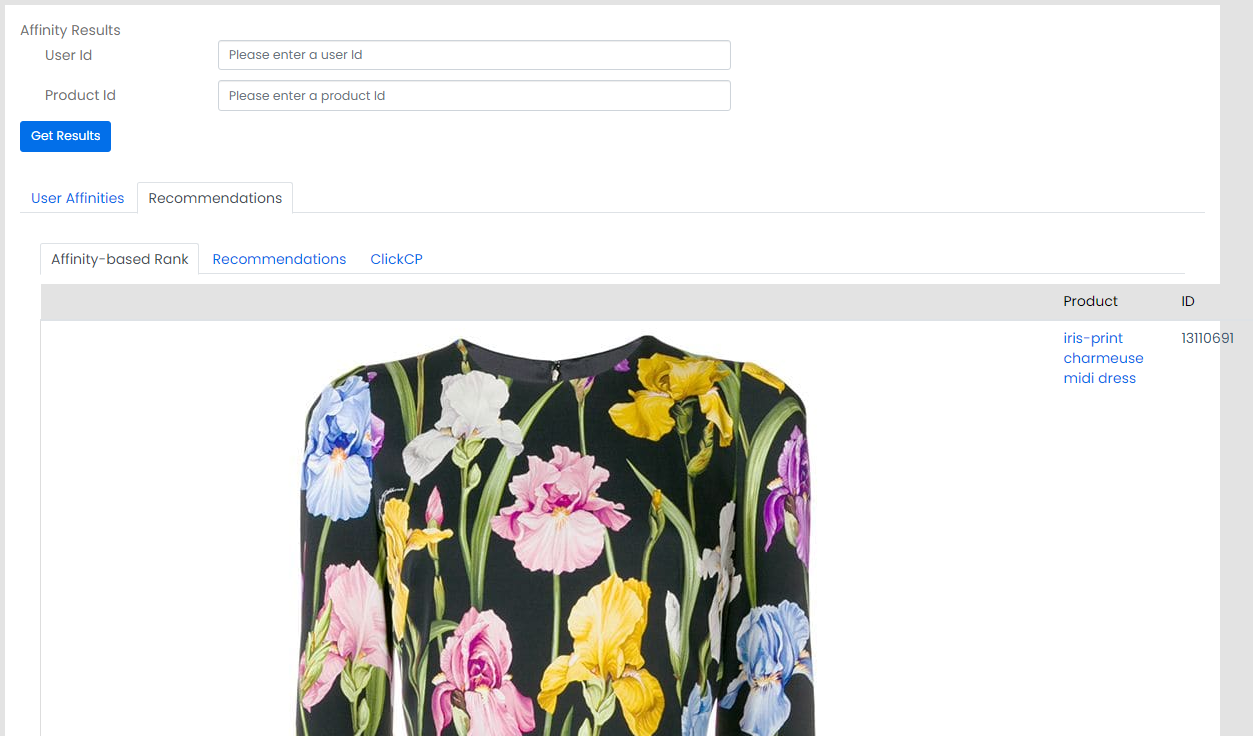
The Recommendations tab is showing the results of the Weighted Mean Reciprocal Weight being applied from your configuration settings.
To determine the best settings, you can test different users and configuration options dynamically. As you add product attributes and change weights, click the Get Results button to see the affinity scores and recommendations from the new configuration.
Once you are satisfied with the recommendations after testing a few sample users, then save the configuration by clicking the Save button in the bottom right of the configuration section.
Note: If you don't save the configuration, navigating away from the page and back will reset your settings.
Once the configuration is saved you can enable the AffinityRankedClickCP strategy under Strategy Configuration or use it in a Strategy Rule.
Monitor the Site Analytics and Strategies reports to see how the strategy is performing. Experience Optimizer will play the strategy more and more if it is performing well compared with the other strategies.
Deleting User Affinity Configuration
You must disassociate the User Affinity Configuration from all Configurable Strategies, Advanced Merchandising rules, Boosting rules, and Engage Campaigns before deleting it.
To delete a user affinity configuration:
- On the Affinity Configuration page, click
 available in the Actions column.
available in the Actions column. - Click OK.
OR
Click ![]() available in the Actions column. The Affinity Configuration page is displayed with the selected user affinity configuration settings.
available in the Actions column. The Affinity Configuration page is displayed with the selected user affinity configuration settings.
Click Delete Configuration.